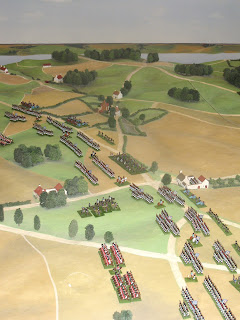While I've finished the basing fix for my SSM figures (last post) basing is still dominating my painting desk. This time it's painting, texturing and dry-brushing the bases for some Games Workshop Lord of the Rings figures to allow my skirmish game to expand so I can play Dragon Rampant or similar. Doubting I'd ever get the figures painted myself (too much else in the queue) I sent them[1] off to Fernando Enterprises in Sri Lanka.
They took longer than I was expecting (c. 6 months) and there was a lot of to and froing as they sent pictures and I requested improvements but eventually they arrived. I was pleasantly surprised to find the figures look much better in the hand than in the photos they sent for approval; the images they send are very small. Now I just had some minor repairs and touching up to do, plus a lot of base work - I had decided to not let them finish the bases as I knew the painting style would be very different to mine and I wanted to make the bases the same as my other figures to help them blend in.
So, first, some of the 'bad guys', goblins ...
... and Warg riders (I don't like Peter Jackson's take on Wargs).
And, ready to ride down everything in their path, THE ROHIRRIM!
I still have some touching up to do on the Uruks, which seem less well-painted than the rest (different painter?) but that shouldn't take long now. So with all these 'armies' gathering war is imminent; no doubt my giant eagles will keeping an eye on things.
As a pleasant interlude during all this, fairly tedious, basing work, I went down to Steve's place for a weekend's gaming get together with some others.
The first game was a 'chit game' of the Battle of Liegnitz (1241) which, true to history, was won by the Mongols. I came seventh out of seven once the VPs were totalled but comforted by the prettiness of my troops (Martin's vintage 15mm Minifig Knights - I had more than this but I liked this close up).
Other games included chariot racing with a modified version of Circus Maximus using Martin's Essex Miniatures chariots ...
... and 6mil Napoleonic game on Steve's sculpted Waterloo terrain (really need to get the backdrop sorted).
This was a fictional Austrian-Bavarian clash (not sure how they ended up in Belgium) and really a play-test for my modified version of Jeffrey's Napoleonic rules as I very much like the command and control system. The game showed promise but there's still work to do. This was not too surprising as I had been adapting it to play on a hex-grid and had to rapidly adjust it for a free-form game on the sculpted terrain, but it is so pretty I'll add a few more photos.
That's all for now.
Notes:
[1.] The lot consisted of: 57 Goblins; 14 Uruk Hai; 7 Goblin Warg riders; 14 mounted Rohirrim and 12 on foot plus a mounted Eomer figure; and, 12 Ithilien Rangers plus Faramir (on foot).


















































